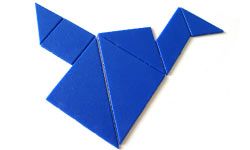The History of Sliding Puzzles
Sliding puzzles started with a bang in 1880. In a matter of months after its introduction, people all over the world were engrossed in trying to solve what came to be known as the 15 Puzzle. It consisted of a 4-by-4 grid, with 15 numbered squares and one space left empty. The idea was to scramble the numbers, then rearrange them into numerical order by sliding them successively into the empty space.
This first sliding puzzle was invented by an upstate New York postmaster named Noyes Chapman, who came up with the idea during the 1870s. Boston woodworker Matthias J. Rice offered a commercial version in 1879 [source: Slocum and Sonneveld]. He called it the Gem Puzzle; other versions were sold as the Boss Puzzle, the Game of Fifteen and the Mystic Square [source: logical-games.org]. The fad took off in the early months of 1880, a puzzle rage that would not be repeated until Rubik's Cube became wildly popular in the 1980s.
Advertisement
Factories could not keep up with the demand for the 15 Puzzle. So many people were caught up in the fad that employers were concerned about workers ignoring their duties to work on the puzzle. Legislators in Germany were seen trying to solve them. Sliding puzzle mania was mentioned in popular songs and plays. Newspapers ran tongue-in-cheek reports of players driven insane by them [source: Slocum and Sonneveld, Bogomolny].
A dentist from Worcester, Massachusetts offered a set of teeth and $100 to any person who could solve the puzzle from a certain beginning arrangement. He later raised the prize to $1,000. People all over the country tried to win this grand sum, but none succeeded. What they didn't know was that only half of all the possible arrangements of pieces can be solved. The dentist's set-up was not solvable [source: Slocum]. The fad faded by the summer of 1880, but the 15 Puzzle remained as a classic slider.
The next development in sliding puzzles came about in 1909 when Lewis W. Hardy invented the first sliding puzzle using pieces that were rectangular rather than square. He called it the Pennant Puzzle, giving it a baseball theme. It was also known as Dad's Puzzle [source: Sharples]. Ma's Puzzle, which followed in 1927, introduced two L-shaped pieces, making it even more difficult to solve [source: Storer].
Over the years, there were many novelty variations on the sliding puzzle. "Capture the Kaiser," featuring pictures of the German ruler, came out during World War I. The 1932 presidential election campaign between Herbert Hoover and Franklin Roosevelt was commemorated in a slider. A puzzle from 1934 called "Line up the Quinties" had players sliding squares with pictures of the famous Dionne quintuplets [source: Rob's Puzzle Page].
Since the computer began to play a role in designing and solving puzzles, the variety of puzzles has increased. Hundreds of pictures have been transformed into sliders, and increasingly more difficult arrangements of geometric shapes have challenged solvers.
Move on to the next section to have a look at some of the different types of sliding puzzles.


